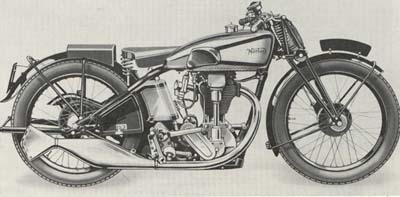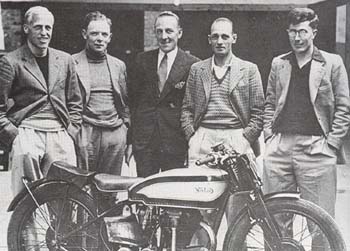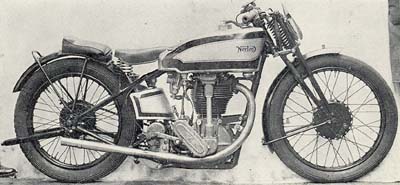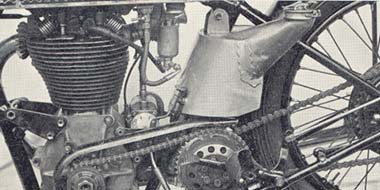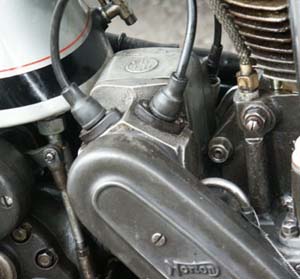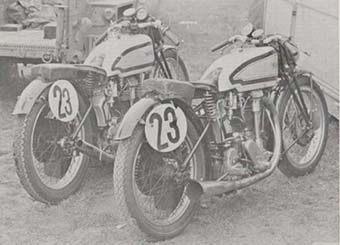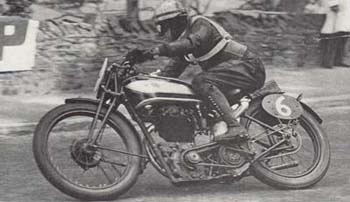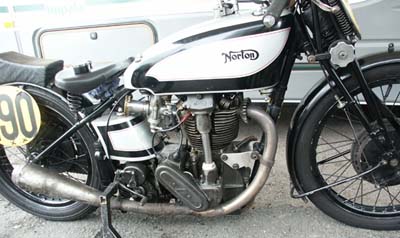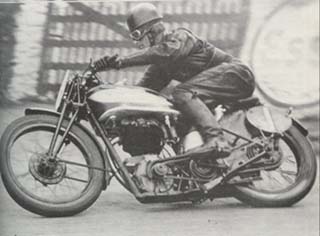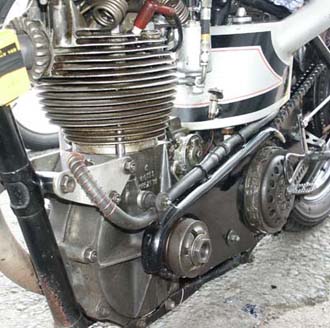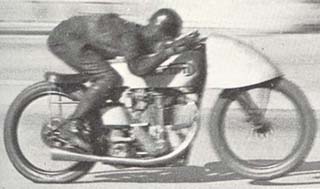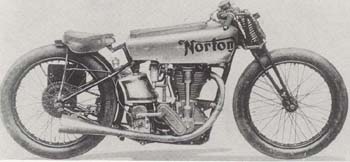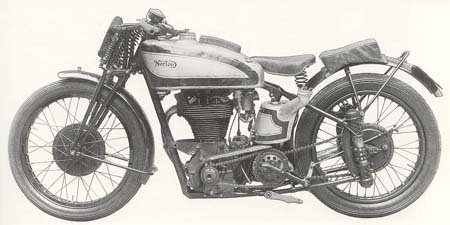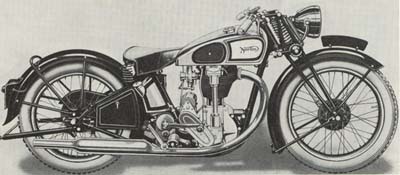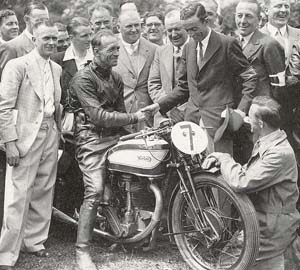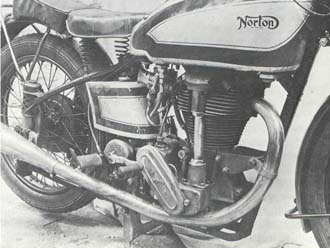The Model 30/40 International Engine
Arrives
As far as the road bikes were concerned, 1932 was an important year
for another reason. It was at this point that the model name ‘International’
was first coined. This designate was given to the sports/racing version
of the customer bike (which were also known by the model name 30 –
for 500cc and 40 – for 350cc). Although they could be ordered
with a variety of options, it was this model, in racing trim, that was
closest the clubman racer would get to a works bike.
Alongside the International, the original CS1 and CJ model continued,
although from this point forward it was of a more ‘touring’
specification than the International. For those wondering how to easily
identify one from another, the most obvious giveaway on the engine is
that the CS1/CJ does not have a downdraught inlet tract. Slightly more
difficult to spot is that the crankcase’s are marginally different
(you really need to see one set alongside another, the timing side webbing
is different). The chassis of a CS1/CJ is also more like that of the
pushrod models in specification, and many are fitted with an ES2 style
petrol tank, rather than the beautiful and distinctive pie-crust International
tanks.
What you can see though on all racing tanks from this point forward, is that the filler was situated on the left, while the non racing tanks were normally on the right. I gather this was mainly as a result of the Isle of Man TT, where the pits were situated such that the mechanics could fill easier from the left.
I did once have a very early wrap-round oil tank from around 1931 vintage. I gather this may have been a ‘works’ type tank, but had a filler on both left and right sides. However, the necks were made to receive screw in (hexagon type) caps, rather than the later butterfly caps that were very distinctive to Norton’s. Stu Rogers told me these were fitted on the earliest wrap round tanks and used the same thread size as the vertical bevel nuts. Interestingly, the tank had a large recess at its base on the right side. If you look very carefully at contemporary photographs of Guthrie sitting on his 1931 TT winning Junior, you can just make out this recess, which looks to have been there to give clearance to the pressed tin cover fitted at that time over the external positive stop mechanism (were these called ‘Thatched Cottage’ gearbox’s?).
1933 again resulted in further improvements to the Works bikes. The main changes being the introduction of bronze alloy heads (which although no lighter than the iron heads, did have better thermal conductivity) and wider brake drums.
I note as well that, looking at contempory photographs, all the remaining main engine castings on the works bikes look to have been produced in magnesium. These included the crankcases (as in previous year), cambox and covers, timing case and cover and even the vertical bevel chamber castings (see my For Sale section for more on this last item).
That year’s TT produced the first ever clean sweep, with a 1,2,3 win in both Junior and Senior events, with Stanley Woods again winning both races.
1933 continued much the same way as 1932, with Norton’s and Stanley
Wood in particular winning almost everything. However, by this time
all was not well in the Norton camp as Joe Craig and Bill Mansell (Nortons
boss) were now using team orders and had tried to force Stanley Woods
to let Hunt win the Ulster GP. The upshot of this was that Mansell had
warned Woods that if he was not prepared to toe the line he would be
out of job.
This probably was not much of a threat to Stanley at the time, as he
had already won a record number of TT’s and would have been much
in demand for his talents.
1934 Season
1934 marked more changes. Particularly the introduction of the bronzed
skulled alloy cylinder, which replaced the bronze alloy heads of the
previous year (I have one of these fitted to my 1938 Racing Inter –
they look very pretty!). The barrel cylinder fins were now alloy as
well (and if you look at a Works Norton, you can also see they have
more finning than a standard Inter).
The other big engine change for 1934 was the introduction of Hairpin
valve springs, replacing the coil springs previously used.
Also new for the 1934 Works bikes were twin spark plugs, with the sparks
coming from a specially made twin spark, single cylinder BTH magneto.
I had never seen one of these in the flesh until I was looking closely
at Ian Bain’s ex works bike (see photo) a few years ago, they
are certainly very special looking devices. Speaking to Ian’s
father, I gather they were fitted with 2 pickup rings, and (if I remember
rightly) a second set of windings on the armature. I believe Norton’s
found there was no real advantage using it though, so they were discarded
after a year or so. They must be one of the rarest (and complex) BTH
magneto’s ever made!
From a chassis perspective, Bolt-thru petrol tanks were used. These
and the oil tanks were also in alloy for the first time, which greatly
reduced weight and the likelihood of leaks (I have been told that alloy
tanks were not adopted on customer racers until 1948 though).
This was also the first year that megaphones were used, small 4 inch
diameter items being employed for most 500cc races (where top speed
was more important than acceleration) and some 350cc races as well.
For the road bikes a larger oil supply to
the cambox was included and a flat washer was incorporated at the base
of the bottom vertical bevel chamber, in case any balls should drop
from the ball races in these chambers. I can confirm first hand that
these washers are very important as the bearings are a real pain! They
are of the self centering variety and when assembling it is very easy
to knock them too far off centre, which often can result in a ball dropping
out of the bronze bearing cage. You then try and replace the dropped
ball, only for 10 more to drop out. A royal pain!!
I spoke to Titch recently about this problem, he chuckled and recounted
that Norton’s weren’t fools, it was probably one of their
best money spinners, with so many engines getting chipped bevel teeth
where an errant ball had found its way into the bottom timing case!
The only real fault of the pre-war ‘Upright’ gearboxes (as opposed to the ‘Laydown’ box’s used from 1950) was the upper mounting location. This was a double lug arrangement, with one lug each side of the frame mount. Unless this was a good tight fit around the frame and kept clamped up tight, play would develop and eventually one of the lugs would snap. Like most owners of pre-war Norton’s, I have seen numerous old shells with this fault!
Adopting a similar principle for the Sturmey Archer clutch’s, they switched to their own design as well. I cover the story of the Norton clutch in a separate section.
Updates to the works bikes continued for 1935. As well as the gearbox changes mentioned above, the engines received even more finning and for the first time, a totally enclosed SOHC cambox, using tappets similar to those later employed in the DOHC cambox. A picture of this cambox can be seen in the Line Drawings section. (Incidentally, I have recently seen a beautiful re-creation of one of these cambox’s, which may be offered for sale in limited numbers in the near future – let me know if you have an interest, but I doubt they will be cheap!). Other smaller changes included a raise in compression ratio and larger fuel tanks.
The TT that year turned out to be another 1,2,3, in the Junior, with Guthrie leading Rusk and White home in that order. The Senior was a different story though, and caused a major upset. Guthrie was favourite for the win, but Stanley Woods (who had previously been having a rough time since leaving Norton’s) was Moto Guzzi mounted and was obviously out to prove a point. Guthrie was away a long time before Woods and up until the last lap held a reasonable lead. However, while he eased off on that last lap, believing Woods still needed to refuel, Woods did the opposite and put in a new lap record at 26min 10sec (without needing to refuel), to bring the Guzzi home to a memorable win.
It was also in this year that Arthur Carroll, designer of the International engine, met an untimely end, in a tragic road accident riding his very fast ‘tweaked’ side valve Norton. Some thought this might result in Joe Craigia
For the first time Inters were supplied with Hairpin valve springs as standard. Aluminium bronze cylinder heads were an optional extra (£5 extra, a small fortune then), but it was pointed out that cast iron heads were less prone to worn valve seats. I can vouch for this with my head, having recently had to have remedial work carried out on the seats for this reason.
In October 1935, just before the Olympia show, Jimmy Guthrie with Joe Craig, took a very unusual looking 500cc Norton to Montlhery to try and break the 1 hour record. They had tried something similar the previous year, but had only succeeded in taking the 50km and 50 mile records.
Running on alcohol and fitted with a 7 gallon fuel tank (looking very much like a contemporary Brooklands bike) there were to be no mistakes this time, and the 1 hr record was taken at an average speed of 114.09mph, with a fastest lap of 118.26mph. This was despite a fuel leak, impairing Guthries vision and without using the nose fairing that had been tried in the previous year.
As a footnote to this record attempt, Stu Rogers has built a beautiful and very exact replica of this record breaker, including a very close copy of the fuel tank and even the nose fairing. I have seen this bike in his workshop and can confirm it certainly looks the business!
For 1936 Plunger rear suspension was used for the first time on the Works bikes. First tried at Brooklands, they employed large diameter springs retained by alloy caps, but no damping. These works frames are easily identified from the later customer frames (1937-38) by their very liberal drilling to the spring casings. To such an extent that they resemble Swiss cheese!
The Brooklands testing was carried out by Crasher White and new team member, Freddie Frith. A 490cc alcohol engine was used, capable of 110mph and this engine was swapped between the spring frame and an older type rigid frame, to give comparison.
White said at the time that he felt it was much more comfortable and seemed to improve handling. Stanley Woods recounted later that he was surprised at the decision for Norton to go with plungers, as the rival Velocette factory had gone with a swinging arm rear suspension at the same time, which he felt gave much better results.
I own a slightly later (1938) customer version of this ‘Big Plunger’ chassis, which previously belonged to Titch Allen. Titch told me that these frames were renowned for breaking almost everywhere! (even more so than the later Gardendate design), so were constantly having to be repaired and strengthened.
Results speak for themselves though, and at their first outing, the Swiss Grand Prix in May, Jimmy Guthrie won both the Senior and the Junior on the new sprung frame bike.
In an effort to extract every ounce of power allowed, that year signified the introduction of a change of bore for the racing machines from 79mm to 79.62mm. This meant the displacement was increased from 490cc to 499cc, as close to the 500cc limit as they could get.
However, changes to the 350cc engine were far more radical with the bore stroke changing from the well known 71 x 88mm to a shorter stroke 73.4 x 82.5mm (resulting in 349cc). This was the first of many bore/stroke changes to Norton racing engines over the coming years, which would make them shorter stroke and take them further away in lineage from their road going counterparts.
This trend towards ‘squarer’ engines gave a more favourable mean piston speed, resulting in more power and better overall reliability.
Again, heads and barrels gained more finning while an 8 inch brake was employed for the first time, replacing the 7 inch item.
1936 was another great year as far as results were concerned. As well as many continental wins, that years TT resulted in Frith winning the Junior (Guthrie was credited with 5th after receiving a push from a marshal, following a chain jumping the sprocket) and a fantastic win from Guthrie in the Senior. This second race turned out to be a titanic battle between Guthrie on the plunger Norton and Stanley Woods, now Velocette mounted with a new swinging arm chassis, with Guthrie reversing his previous years fortune, and just pipping Woods to the post.
I was given a couple of these unusual carburettors many years ago, by an old friend and previous Gold Star holder, Bob Pike. I remember fitting one to my current road bike of the time, a rather sporty 1955 Norton ES2. What I remember most about it was it spitting back on me, when kickstarting outside the local supermarket. The small fire that ensued resulted in much hand flapping and swearing!
If memory serves me right, it was shortly after that I graciously (!) donated both carbs to Titch and Roger Allen for their replica of the supercharged Wicksteed Triumph, now residing in the Brooklands museum.
